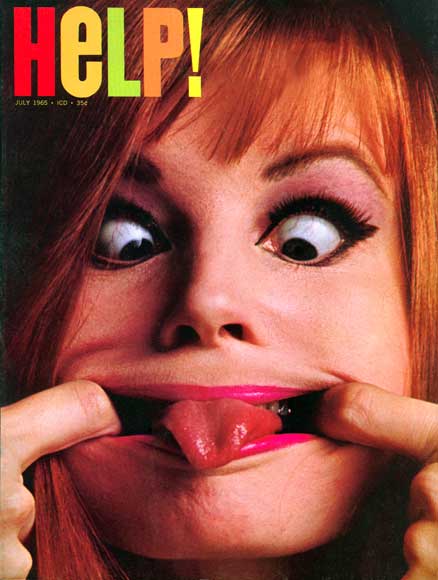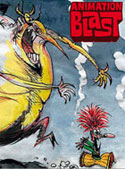The Art of Harvey Kurtzman: The Mad Genius of Comics (Denis Kitchen and Paul Buhle, Abrams ComicArts, $40)
In his introduction to this groundbreaking book, comedian/writer Harry Shearer declares: “Without Harvey Kurtzman, there would have been no Saturday Night Live. What a horrible thing to say about him, but it’s true. . . . OK, this might be better. Without Harvey Kurtzman, there would have been no Simpsons.”

All hyperbole aside, there is much truth in this statement, and, like many other influential artists, Harvey Kurtzman seldom receives the credit he is due for shaping much of what we know as satire in postwar America. As the creator of MAD magazine, Kurtzman had many roles: artist, editor, writer, and ringleader. He nurtured the burgeoning underground comics movement, and his paperback comic novel, The Jungle Book, may have well been the first graphic novel, appearing years before Will Eisner’s Contract with God, which is usually considered the original graphic novel. He gave Gloria Steinem her first job in publishing. He brought John Cleese and Terry Gilliam together and was responsible for publishing some of Robert Crumb’s earliest work. And without Kurtzman’s other, more adult magazines, Humbug, Trump and Help, there very well might not have been a National Lampoon or Spy.
The Art of Harvey Kurtzman is the first large-scale retrospective of Harvey Kurtzman’s work, written by Denis Kitchen, a legend in underground comics in his own right, and scholar Paul Buhle. It traverses his stunning career, outlining how much of an impact his life and work had not only in the comics industry, but on pop culture itself. The book itself is a striking example high production aesthetic, an amazing compendium of Kurtzman’s personal drawings, comic strips, layouts and comic “essays” he did for magazines like Esquire.
Chapters cover the major parts of his life, pre and post MAD, giving just as much credence and attention to those periods as the MAD years. And what the book does remarkably well is show what an amazing cartoonist he was in his own right, standing toe to toe with the other amazing roster of artists that surrounded him. Will Elder, Jack Davis and Wally Wood were amazing draftsman’s to be sure, but it was Kurtzman’s ability to capture a mood, or a sense of movement, of weight in just a few strokes of the pen or pencil that is evident in every drawing presented in the book. Animator John K has often sited Kurtzman’s drawing skills on his blog, dissecting not only Kurtzman’s use of the Line of Action but his canny ability to layout a page, giving story and art equal time in terms of overall impact.
The book pays a grea t deal of attention to Harvey Kurtzman’s process, which could be fairly intricate (often times Kurtzman would write and layout pages, much to the chagrin of some artists who were working for him). Many of his initial thumbnails and final layouts of pages are presented, along with the finished product.
t deal of attention to Harvey Kurtzman’s process, which could be fairly intricate (often times Kurtzman would write and layout pages, much to the chagrin of some artists who were working for him). Many of his initial thumbnails and final layouts of pages are presented, along with the finished product.
There is a long chapter covering much of Kurtzman’s earliest work for EC, Two-Fisted Tales and Frontline Combat. The book reprints in full (one of several complete reprintings) the classic story “Corpse on the Imjin!” which not only displays Kurtzman’s uniquely human storytelling, but his amazing artistic skills. Much more stylized than any other artists on the EC war comics roster, his illustrations were boldly inked, and superbly designed, the impact much greater then a hyper-realistic interpretation.
The Art of Harvey Kurtzman reprints many comics from various projects, often times in their entirety. There is the famous “Superduperman” from MAD, illustrated by Wally Wood, a never before seen proof of a 3-D spoof comic, and probably, most striking of all, a section that reprints a page from a little Annie Fannie story, complete with preproductions all of the vellum overlays (using actual vellum) that Kurtzman produced for his partner—the amazing Will Elder—to work from. These reprints are often the highlights of the book, as they are sometimes the original proofs, accompanied by the original layouts and contextualized with detailed background on how each was designed and developed.

The Trump, Humbug and Help, years are also covered in depth, with many of the covers reprinted as well as often time hilarious promotional photos of the people involved in their creation.
Long on amazing art, The Art of Harvey Kurtzman is sometimes lacking in it’s overview of the man himself. A few years back Fantagrpahics released a fanatastic book as part of their library series, Harvey Kurtzman: TCJ Library Vol. 7 in which every major interview that appeared in the Comics Journal—along with other famous interviews in other magazines—were reprinted in their entirety. The interviews often time give a bit more depth and background than The Art of Harvey Kurtzman provides. And like The Art of, Harvey Kurtzman: TCJ Library Vol. 7 , includes a wealth of stunning visual material, some of which is not covered in The Art of.
In many ways The Art of Harvey Kurtzman: The Mad Genius of Comics is almost years too late. The fact that it took this long for an edition like this to emerge, is just another example of an artist only receiving credit for their groundbreaking achievements after they are dead. On the other hand, it is wonderful that there is finally a book like this that catalogues all of Harvey Kurtzman’s amazing achievements, hopefully inspiring a new generation of cartoonists who many have never even heard his name before.











 If you like ACTION, THRILLS, ADVENTURE and ARMED FLYING SQUIRRELS WITH DEGREES IN LITHUANIAN BASKET WEAVING, look no further, you have come to the right place! That's correct, folks, your entertainment dollars go further at this Website---SCOTT BROTHERS and his CATALOGUE OF CURIOSITIES---because it's FREE! Shake off feelings of BOREDOM, REGRET and SOUL-CRUSHING EMPTINESS just by looking through our pages! Nothing else to purchase to become the LIFE OF THE PARTY! With SCOTT BROTHERS and his CATALOGUE OF CURIOSITIES you can see through WALLS, produce SHRUNKEN HEADS and become as strong as CHARLES ATLAS! No money back if not 100 percent satisfied.
If you like ACTION, THRILLS, ADVENTURE and ARMED FLYING SQUIRRELS WITH DEGREES IN LITHUANIAN BASKET WEAVING, look no further, you have come to the right place! That's correct, folks, your entertainment dollars go further at this Website---SCOTT BROTHERS and his CATALOGUE OF CURIOSITIES---because it's FREE! Shake off feelings of BOREDOM, REGRET and SOUL-CRUSHING EMPTINESS just by looking through our pages! Nothing else to purchase to become the LIFE OF THE PARTY! With SCOTT BROTHERS and his CATALOGUE OF CURIOSITIES you can see through WALLS, produce SHRUNKEN HEADS and become as strong as CHARLES ATLAS! No money back if not 100 percent satisfied.



















